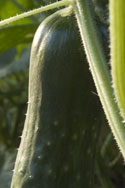
Photo © Steven Foster
Introduction
The cucumber is part of the gourd and squash family and is native to India and Egypt. Cucumis is Latin for gourd and sativus signifies the plant has a long history of cultivation.1 The plant is a trailing annual that produces yellow, funnel shaped flowers in the spring and summer. The leaves, fruits, seeds, and oil are all cultivated for a variety of uses.2 History and Cultural Significance
The cucumber is one of the oldest cultivated vegetables with a history of more than 4000 years of cultural use.3 In biblical times, the cucumber was thought to provide protection against snakes and insects.1 Buddhists mention the cucumber as an emblem of fertility. In the days before thermos jugs, travelers would carry cucumbers because of their high water content (96%) and ability to soothe thirst. Alexander the Great introduced the cucumber to Europe and Julius Caesar was a proponent of the vegetable in Roman times. Columbus is credited with bringing the cucumber to the Western Hemisphere in 1494.1 Today, people often utilize the cucumber for its culinary properties. Generally, the cucumber is eaten raw. It is common to see the vegetable sliced up into a salad or added to yogurt or sour cream to make tzatziki, a Greek sauce.2 The English have made the cucumber sandwich a tradition in customary afternoon tea. The vegetable can commonly be found lightly cooked in the East.3 The United States uses over 70% of the crop in converting cucumbers to pickles.1 The French will press the cucumber seeds into cucumber oil that can be substituted for olive oil.2 The cucumber is also used today for other benefits. Applied externally, the vegetable is used to soothe sunburn and tired eyes either by slicing the cucumber and putting the slices on the skin, or by making a puree to spread over the skin.4 It may aid in digestion since it contains an enzyme that digests proteins. The fruit of the cucumber plant is used in the cosmetic industry in facial cleansing and toning lotions.2 Modern Research
One study indicates that cucumber consumption may help protect cells against damage from internal and external forces.5 A toothpaste made with cucumber extract is showing promising outcomes with respect to gum disease in randomized, controlled trials.6 Future Outlook
Very little information is available on the commercial production and market statistics of C. sativus. Cucumber crops can be affected by susceptibility to certain diseases, insects and nematodes, so resistant varieties must be selected for commercial production.7 Some varieties are also susceptible to moisture loss during transportation, so proper packaging is important.8 References
1 Onstad D. Whole Foods Companion. White River Junction, VT: Chelsea Green Publishing Co.; 1996. 2 Bown D. The Herb Society of America New Encyclopedia of Herbs and Their Uses. London: Dorling Kindersley Ltd.; 2001. 3 Davidson A. The Oxford Companion to Food. New York: Oxford University Press; 1999. 4 Duke JA. The Green Pharmacy. Emmaus, PA: Rodale Press; 1997. 5 Edenharder R, et al. Protective effects of fruits and vegetables against in vivo clastogenicity of cyclosphosphamide or benzo[a]pyrene in mice. Food & Chemical Toxicology. 1998:36(8);637-645. 6 Taiyeb-Ali TB, Zainuddin SL, Swaminathan D, et al. Efficacy of “Gamadent” toothpaste on the healing of gingival tissues: a preliminary report. J Oral Sci. 2003;45(3):153-9. 7 Hochmuth RC. Greenhouse Cucumber Production - Florida Greenhouse Vegetable Production Handbook, Vol 3. University of Florida IFAS Extension. Available at: http://edis.ifas.ufl.edu/CV268. Accessed 3/10/2005.
|